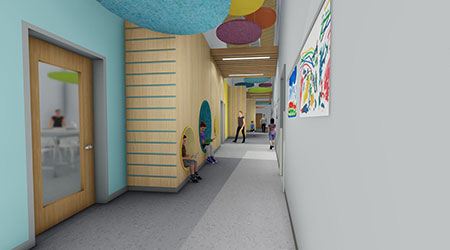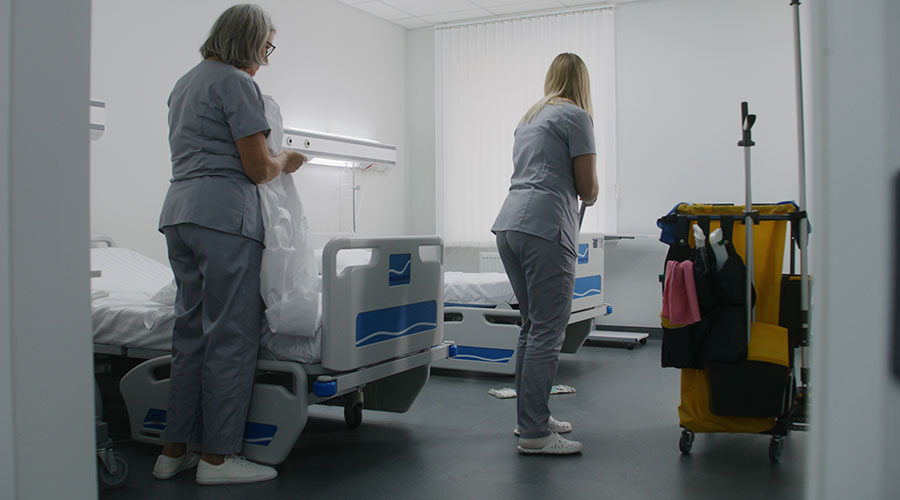As we enter a new decade, there are several challenges that lay ahead for the hospital design industry to address: recruitment and retention, integrating research and technology and population health issues. Below are the trends that healthcare facilities are navigating.
Embracing the employee environments
You may recall the book, If Disney Ran Your Hospital, by Fred Lee. Years ago, healthcare leaders became aware that patients compare satisfaction scores and online reviews against all service industries, not just other healthcare organizations. To maintain market share, patient satisfaction quickly made its way to the top of the priority list.
Now, healthcare providers are facing a new challenge in providing quality healthcare, retaining top talent. Recent trends illustrate that improved workplace environments increase staff satisfaction and are a critical factor in a facility’s success.
As companies like Google, Abercrombie & Fitch, HubSpot, and Apple received accolades and recognition for their updated, flexible work environments and company culture, it was not long before clinical teams began to expect similar advancements. T
o address these changing expectations, and as part of the primary criteria when embarking on new projects, healthcare organizations are beginning to acknowledge and highlight their greatest asset, their people. Additionally, staff support spaces are no longer an afterthought when designing new infrastructure.
Dark, windowless break rooms with towering lockers and tables crowded with mismatched chairs, or nursing rooms in converted storage closets are no longer acceptable to prospective employees.
Workplace environments should incorporate natural light, respite areas with comfortable furniture, coffee bars, beautiful artwork, wellness rooms, daybeds, outdoor spaces, and more. Healthcare facilities may not have everything a Forbes 500 company may have in order to support recruitment and retention, but don’t be surprised if you soon hear a nurse exclaim, “Table tennis anyone?”
Increasing female leadership
Though female leadership in the healthcare industry is 35% and rising, leadership positions in architecture firms are slow to reflect this change. Out of the top 100 architecture firms in the country, only one is led by a woman.
With the launch of multiple industry initiatives such as the AIA Women’s Leadership Summit and the growth of Professional Women in Construction (PWC), the A/E/C industry is supporting action to balance leadership and increase diversity. Increasing diversity in architecture will not only improve one’s ability to design healthcare environments, but it improves staff retention and company morale.
Making room for new technology
The integration of technology in healthcare and its impact on existing facilities will require institutions to consider completely new models and spaces for healthcare delivery. This will require institutions to be at the leading edge of new delivery models for care, including:
• Leasing space from developer-led buildings to fast-track construction and provide greater flexibility in providing appropriate responses to the changing healthcare landscape
•Placing a heavier emphasis on incubator space for research and development in the creation of new treatments for each individual patient
•An increased focus on data collection to anticipate future health conditions and study overall trends
•Promoting preventative medicine with a regionalized approach to healthcare delivery through outpatient sites and tele-medicine
Personalized medicine manufacturing within the healthcare campus
In response to the growing demand for next-generation personalized medicine such as cellular, gene, and immune therapies, the pharmaceutical industry has been constructing large FDA regulated (cGMP) genomic manufacturing facilities outside dense population centers.
While this approach initially reduces land acquisition and construction costs, the model isolates manufacturing operations from the patient and the life science ecosystem that fosters discovery and collaboration. Remote facilities also require expensive dedicated couriers, delaying the return of time-critical therapies to patients, while increasing the risk that the product might be damaged or lost during transport.
In 2020 and beyond, expect to realize automated personalized medicine platforms that perform gene manipulations within, or directly adjacent to, the point of care or academic medical research centers. This decentralized model can scale up quickly, requires significantly less space, and reduces the time it takes to return manipulated cells to the patient while increasing quality assurance.
While the first generation may include hospital staff performing FDA regulated operations, using pharmaceutical industry personnel will enhance quality control and lessen any possible conflicts of interest in therapy development.
Holistic approach to population health
Population health management is a holistic approach to healthcare that considers the overall environment of an individual and their community. Determining factors include economic stability, neighborhood and physical environment, education, support system (family, friends, work, religious affiliation), access to transportation, nourishment and healthcare. Research clearly demonstrates that 60% of health is determined by social, behavioral, and environmental factors.
These factors have dramatic impacts, such as a 10-year lifespan difference found between residents from affluent neighborhoods versus low-income neighborhoods. This means that the number one determining factor of life expectancy isn’t how much you work out or what type of food you eat, it’s your zip code.
Healthcare organizations know that patients will return to home environments that vary from person to person. These home environments not only affect an individual’s overall health, but the recovery process as well.
To improve outcomes, healthcare organizations are now looking at factors outside of the hospital setting. To evaluate and better understand these inequities, healthcare systems are engaging with community organizations to identify problem areas and develop a strategic approach to managing population health.
Design methodologies such as WELL consider many of the same factors as population health management does in the design of work, living, and caregiving spaces thus allowing the ability to make an impact on people’s overall health.
For more information, visit www.e4harchitecture.com.

 Disinfectant Dispensers in Healthcare Facilities Often Fail to Deliver Safe Concentrations: Study
Disinfectant Dispensers in Healthcare Facilities Often Fail to Deliver Safe Concentrations: Study Duke University Health System Receives $50 Million for Proton Beam Therapy Center
Duke University Health System Receives $50 Million for Proton Beam Therapy Center UT Southwestern Experiences Data Breach Through Calendar Tool
UT Southwestern Experiences Data Breach Through Calendar Tool Protecting Patient Data: Strategies and Tactics
Protecting Patient Data: Strategies and Tactics Duke Health to Acquire Lake Norman Regional Medical Center
Duke Health to Acquire Lake Norman Regional Medical Center